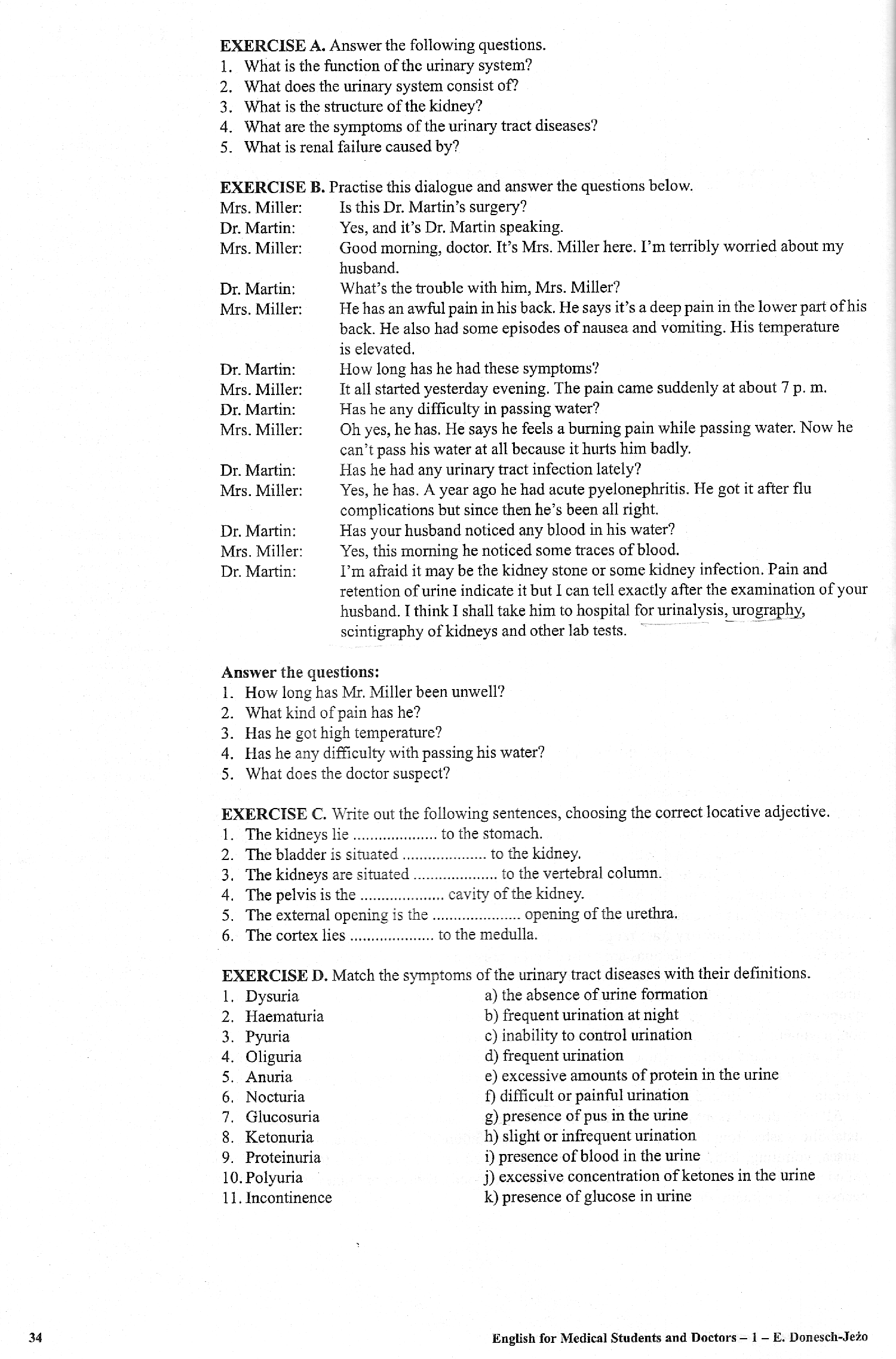34

34
EXERCI.SE A. Answer the following ąuestions.
1. What is the function of the urinary system?
2. What does the urinary system consist of?
3. What is the structure of the kidney?
4. What are the symptoms of the urinary tract diseases?
5. What is renal failure caused by?
EXERCISE B. Practise this dialogue and answer the ąuestions below.
Mrs. Miller: Is this Dr. Martini surgery?
Dr. Martin: Yes, and it’s Dr. Martin speaking.
Mrs. Miller: Good moming, doctor. It’s Mrs. Miller here. I’m terribly worried about my
Dr. Martin: Mrs. Miller:
Dr. Martin: Mrs. Miller: Dr. Martin: Mrs. Miller:
Dr. Martin: Mrs. Miller:
Dr. Martin: Mrs. Miller: Dr. Martin:
husband.
What’s the trouble with him, Mrs. Miller?
He has an awful pain in his back. He says it’s a deep pain in the lower part of his back. He also had some episodes of nausea and vomiting. His temperaturę is elevated.
How long has he had these symptoms?
It all started yesterday evening. The pain came suddenly at about 7 p. m.
Has he any difficulty in passing water?
Oh yes, he has. He says he feels a buming pain while passing water. Now he can’t pass his water at all because it hurts him badly.
Has he had any urinary tract infection lately?
Yes, he has. A year ago he had acute pyelonephritis. He got it after fiu complications but sińce then he’s been all right.
Has your husband noticed any blood in his water?
Yes, this moming he noticed some traces of blood.
I’m affaid it may be the kidney stone or some kidney infection. Pain and retention of urine indicate it but I can tell exactly after the examination of your husband. I think I shall take him to hospital for urinalysis, urography, scintigraphy of kidneys and other lab tests.
Answer the ąuestions:
1. How long has Mr. Miller been unwell?
2. What kind of pain has he?
3. Has he got high temperaturę?
4. Has he any difficulty with passing his water?
5. What does the doctor suspect?
EXERCISE C. Write out the following sentences, choosing the correct locative adjective.
|
1. |
The kidneys lie................... |
. to the stornach. |
|
2. |
The bladder is situated....... |
.............to the kidney. |
|
3. |
The kidneys are situated..... |
...............to the vertebral column. |
|
4. |
The pelvis is the................. |
... cavity of the kidney. |
|
5. |
The extemal opening is the |
.....................opening of the urethra. |
|
6. |
The cortex lies.................... |
to the medulla. |
|
EXERCISE D. Match the symptoms of the urinary tract diseases with their defmitions. | ||
|
1. |
Dysuria |
a) the absence of urine formation |
|
2. |
Haematuria |
b) freąuent urination at night |
|
3. |
Pyuria |
c) inability to control urination |
|
4. |
Oliguria |
d) freąuent urination |
|
5. |
Anuria |
e) excessive amounts of protein in the urine |
|
6. |
Nocturia |
f) difficult or painful urination |
|
7. |
Glucosuria |
g) presence of pus in the urine |
|
8. |
Ketonuria |
h) slight or inffeąuent urination |
|
9. |
Proteinuria |
i) presence of blood in the urine |
|
10 |
. Polyuria |
j) excessive concentration of ketones in the urine |
|
11 |
. Incontinence |
k) presence of glucose in urine |
English for Medical Students and Doctors - 1 - E. Donesch-Jeżo
Wyszukiwarka
Podobne podstrony:
20(1) EXERCISE A. Answer the following ąuestions. 1; What processes does the respiration consist of?
MiaHM back THE MOONIS A HARSH M1STRESS i In what is considered one of his most hair-raising, thought
Electronic Lab ManuałLaboratory Exerci.se 10 -13 : Shift Registers Shift registers are a type of seq
+ x direction enters at time / = 0 the region x > 0 in which sound speed c( x) is a random functi
[14] (4) What is thc output of medium size gasifier? (a) 10-40 kW (b) 10-50 kW (c)
EXERCISE A. Answer the folio wing ąuestions. 1. What are the functions ofthe diges
EXERCISE A. Answer the following questions: 1. What are the main parts of the huma
Obraz0006 (3) w III Answer the following ąuestions in the space provided 1. Discuss the rnain differ
TELEVISION IN GREAT BRITAIN3 EXERCISESI. Answer the ąuestions. 1. Can you describe
S0121/S1687 BOTANY: PAPER II Q.l (B) Answer the following in one sentence (a) What
Answer the following ąuestions toText 2. 1. Why is everything in the Tip-Top Beaut
ANG2 k2 05 3 III. Stock Exchange terms. A) Complete the following sentences and answer the following
więcej podobnych podstron